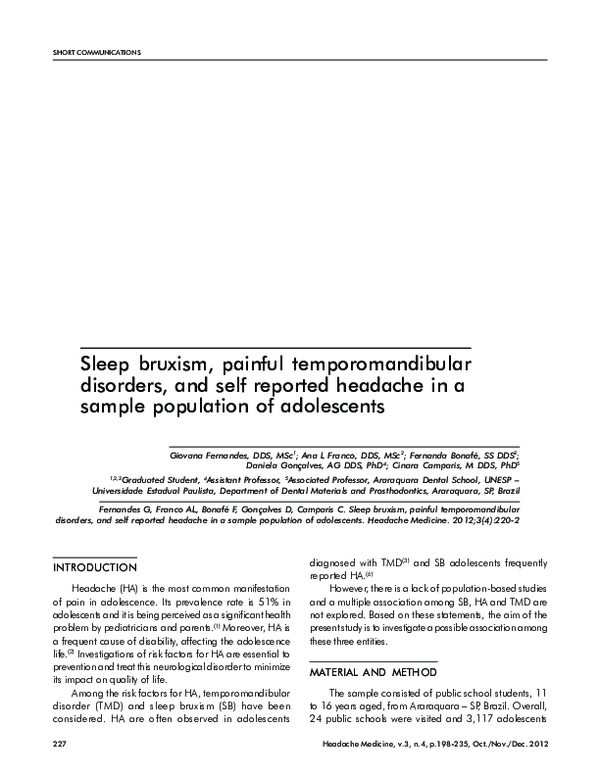Academia.edu no longer supports Internet Explorer.
To browse Academia.edu and the wider internet faster and more securely, please take a few seconds to upgrade your browser.
Sleep bruxism, painful temporomandibular disorders, and self reported headache in a sample population of adolescents
Sleep bruxism, painful temporomandibular disorders, and self reported headache in a sample population of adolescents
2012, Revista Headache Medicine
Related Papers
Revista Headache Medicine
Headache complaints increase the risk for temporomandibular disorder among Brazilian adolescents: A population-based study2012 •
The Clinical Journal of Pain
Headache Associated With Temporomandibular Disorders Among Young Brazilian Adolescents2014 •
The Journal of Pain
Painful Temporomandibular Disorder Is Associated With Migraine in Adolescents: A Case-Control Study2019 •
Journal of Oral & Facial Pain and Headache
Headache Attributed to Temporomandibular Disorders: Axis I and II Findings According to the Diagnostic Criteria for Temporomandibular Disorders2021 •
Pain research & management
Temporomandibular Disorders and Headache: A Retrospective Analysis of 1198 Patients2017 •
Aim. Headache is one of the most common diseases associated with Temporomandibular Disorders (TMDs). The aim of this study was to evaluate, retrospectively, if headache influences TMD's symptoms. Material and Methods. A total sample of 1198 consecutive TMD patients was selected. After a neurological examination, a diagnosis of headache, according to the latest edition of the International Classification of Headache Disorders, was performed in 625 subjects. Patients were divided into two groups based on presence/absence of headache: Group with Headache (GwH) and Group without Headache (GwoH). Descriptive statistics and Chi-square index were performed. Results. Sociodemographic (gender, marital status, and occupation) and functional factors, occlusion (occlusal and skeletal classes, dental formula, and occlusal abnormalities), and familiar pain did not show a statistically significant correlation in either group. Intensity and frequency of neck pain, arthralgia of TMJ, and myalgia...
Cephalalgia
Are signs of temporomandibular disorders stable and predictable in adolescents with headache?2008 •
Cephalalgia
Headache children with temporomandibular disorders have several types of pain and other symptoms2005 •
Journal of Oral Science
Association between headache and temporomandibular joint disorders in children and adolescents2013 •
Journal of Oral & Facial Pain and Headache
Temporomandibular Disorder Pain and Related Factors in an Adult Population: A Cross-Sectional Study in Southern Sweden2017 •
RELATED PAPERS
S. Piazzese, Schelling e Pareyson: sulla rilevanza filosofica del cristianesimo come pensiero tragico, in «Lo Sguardo», N. 34, 2022 (I), pp. 357-368
Schelling e Pareyson: sulla rilevanza filosofica del cristianesimo come pensiero tragico2023 •
Culture et Démocratie
Penser avec les zones humides, en quête d'avenirs désirables2023 •
Energy Sources, Part B: Economics, Planning, and Policy
Exploring drivers of sectoral electricity demand in Indonesia2018 •
Journal of Applied Communication Research
Communication and resilience: multilevel applications and insights – A <i>Journal of Applied Communication Research</i> forum2018 •
Pravo - teorija i praksa
A legal status of former owners in the restitution process in Serbia2017 •
Pabrik Box Fiberglass Motorcycle, Pabrik Box Motor Fiberglass bandung, Pabrik Fiberglass custom Box, Pabrik Fiberglass cooler Box, Pabrik Box Motor Delivery Fiberglass, Pabrik Fiberglass Box for Motorcycle
TELP/WA : 0822.3006.6162, Grosir Box Fiberglass untuk Makanan, Grosir Box Fiberglass Rumah Makan, Grosir Box Fiberglass untuk Minuman2007 •
2020 •
2021 •
Interdisciplinary journal of research and development
Influence of Facial Profiles, Posture and Balance2024 •
2022 •
RELATED TOPICS
- Find new research papers in:
- Physics
- Chemistry
- Biology
- Health Sciences
- Ecology
- Earth Sciences
- Cognitive Science
- Mathematics
- Computer Science

 Cinara Maria Camparis
Cinara Maria Camparis